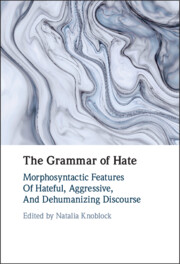Book contents
- The Grammar of Hate
- The Grammar of Hate
- Copyright page
- Contents
- Figures
- Tables
- Contributors
- Acknowledgments
- Introduction
- 1 Animacy and Countability of Slurs
- 2 Language Aggression in English Slang: The Case of the -o Suffix
- 3 Adj+ie/y Nominalizations in Contemporary English
- 4 Grammatical Gender and Offensiveness in Modern Greek Slang Vocabulary
- 5 Unseen Gender
- 6 The Neutering Neuter
- 7 Neutering Unpopular Politicians
- 8 The Power of a Pronoun
- 9 Is Play on Words Fair Play or Dirty Play?
- 10 Expressive German Adjective and Noun Compounds in Aggressive Discourse
- 11 ‘Kill the Invaders’
- 12 ‘I am no racist but …’
- 13 Homophobic Space–Times
- Index
- References
7 - Neutering Unpopular Politicians
The Neuter Gender and ‘It’ as a Dehumanizing Grammatical Metaphor
Published online by Cambridge University Press: 30 June 2022
- The Grammar of Hate
- The Grammar of Hate
- Copyright page
- Contents
- Figures
- Tables
- Contributors
- Acknowledgments
- Introduction
- 1 Animacy and Countability of Slurs
- 2 Language Aggression in English Slang: The Case of the -o Suffix
- 3 Adj+ie/y Nominalizations in Contemporary English
- 4 Grammatical Gender and Offensiveness in Modern Greek Slang Vocabulary
- 5 Unseen Gender
- 6 The Neutering Neuter
- 7 Neutering Unpopular Politicians
- 8 The Power of a Pronoun
- 9 Is Play on Words Fair Play or Dirty Play?
- 10 Expressive German Adjective and Noun Compounds in Aggressive Discourse
- 11 ‘Kill the Invaders’
- 12 ‘I am no racist but …’
- 13 Homophobic Space–Times
- Index
- References
Summary
The chapter demonstrates the expressive and evaluative potential of grammatical gender and specifically highlights the ways ‘grammatical neutering’ can be used to belittle and other unpopular politicians. The authors develop the idea that in gendered languages intentional deviations from a grammatical norm are pragmatically loaded and express a notable implicit message. They present a number of examples collected from online Ukrainian-language sources where the neuter pronoun vono (it) was used to refer to two presidents: Putin, the president of the Russian Federation, and Zelensky, the president of Ukraine. Viewing such examples as cases of grammatical metaphor, the authors show that classifying a referent as ‘other’ may be achieved not only by lexical but also by grammatical means. The application of it and neuter morphology where feminine or masculine is expected while expressing disapproval produces a strong pragmatic effect. The addition of grammatical dehumanization and desexualization to derogatory semantic propositions magnifies the utterances’ negative impact and helps to communicate antipathy and dissociation. The chapter discusses the communicative consequences of grammatical metaphorization of the neuter third person pronoun in Ukrainian political discourse, drawing conclusions about pragmatic effects of grammatical gender alternations.
Keywords
- Type
- Chapter
- Information
- The Grammar of HateMorphosyntactic Features of Hateful, Aggressive, and Dehumanizing Discourse, pp. 140 - 160Publisher: Cambridge University PressPrint publication year: 2022

